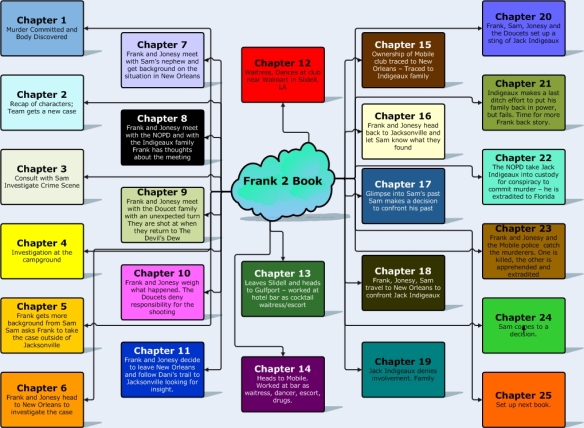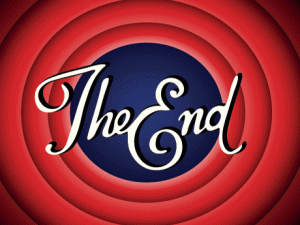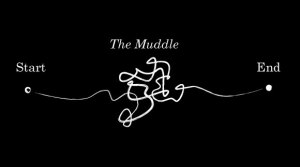I am on the verge of publishing novels seven and eight of my writing career. I wouldn’t say that I’m anything close to being an expert, but I decided to use my Hurricane Irma downtime to look back on the books I’ve written and the process that I followed.
 Step 1 – The Premise
Step 1 – The Premise
The premise is just a general idea of what a book will be about. I’m going to use my second novel, Let Me Be Frank, as the example for this post.
The premise for this book was simple. I had just binge watched the 1970s television show, Columbo, and I was intrigued by the structure of most of the episodes. The show almost always started with a murder and very often showed the murderer and the method used to do in the victim. It was then up to Lieutenant Columbo to solve the case and trick the murderer into a self-condemning situation. This was my single plot idea going in and the book evolved from there.
Step 2 – The Opening Scene
This might seem like a dive into the weeds in terms of detail for the book, but think of it as a first impression. When you meet someone new, the things you initially say or do will leave a lasting impression and help them form their opinion of you as a person.
Books are similar to a much greater degree. Beyond your book cover, you have a few pages to catch the attention of your reader so that they’ll want to continue on and read what you’ve written. If they lose interest early on, you may have lost them as a reader for not only this book, but for your other work.
In Let Me Be Frank, my editor and good friend actually suggested something different as a way to make the scene more compelling. She suggested writing the scene from the point of view of the victim. In the scene, the victim, Dani Indigeaux, is walking home from work listening to music when she is attacked and murdered in cold blood. We see the crime from her perspective and then we here from the murderers as they deal with the aftermath of the crime. It is then up to my detective duo, Frank Rozzani and Clifford “Jonesy” Jones to determine the motive, solve the crime and capture the murderers.
Here is an excerpt from that opening scene:
Things were turning around. Since coming to Jacksonville six months ago Dani was finally starting to feel like life might turn out okay. Thanks to Uncle Sam she had a place to live and money for food and to buy a few things. She was so lucky that Sam Monreaux remembered her family and had taken her in. For the first time in a very long time, she felt like there was some hope. She could feel the bills from the tips she earned in her pocket. She might be able to buy a television for her apartment with the money she had saved.
As she walked home after closing time at the Sun Dog, she thought of all the possibilities. She turned down the dark alley that was a shortcut to her apartment building. Sam owned the building and many of its occupants worked at the Sun Dog. Rent was paid based on what she thought she could afford. Sam never asked for more. She thought about how fortunate she was to have this second chance. As she walked she listened to Lorde on the second-hand iPhone that someone had given her. She enjoyed walking home. It was late. The Sun Dog closed at 2AM and she had worked serving drinks and bar food until then. Frank Rozzani’s trio was playing tonight and the drummer had offered her a ride home. The walk was short, though, and she enjoyed walking in the humid air with the smell of the saltwater in her nostrils. The area was safe, and, even though he seemed nice, she didn’t want to accept a ride from a man this late. She just couldn’t do it.
She didn’t hear the white panel van stop at the end of the alley or the approaching sound of footsteps. The two men pursuing her were surprisingly quiet considering their size. One man carried a pistol and the other a tarp. They were cold and calculating in their mission. Their boss had been very clear. There was to be no mercy. The girl must die to deliver a message.
Step 3 – The Ending
I know this might seem out of order, but very often, an author may have the end of a novel in mind right from the premise stage. It is said that J.K. Rowling had the ending of the seven-book Harry Potter series in mind from the very beginning and that her books worked toward that ending.
I think it’s a good idea to have an ending in mind. It gives you a destination and the rest of your book should be a road map to get there.
In Let Me Be Frank, I had the ending in mind before any other aspect of the book. I new I wanted some kind of transformation for the main characters. In particular, one of the secondary characters, Sam “Fat Sam” Monreaux, was going to undergo a life changing event that would solidify his standing in the Frank Rozzani universe as an important ally going forward in this book and the anticipated continuation of the series which is now five books in.
Step 4 – The Middle
This is often the toughest part of the novel. I’ve written about it in other posts (HERE) and have referred to it as “the muddle”. It’s where books lose steam and, sometimes, lose readers. Let Me Be Frank takes readers on a journey around the gulf states as Frank and Jonesy take on alternate identities to investigate the case. I made this middle section fun to write and injected some humor to keep the reader on the hook until the book worked its way to the twist-filled ending.
The middle is an important part of your book and usually takes the most work to get it where it needs to be.
Bonus Step – Putting it Together in a Picture
I will start this bonus step by saying that I’m definitely not an outliner, but I do start with a pictorial view of where my books is going to go. This view is called a mind map.
I’ve written other blog posts on the mind mapping technique that I use. You can read one HERE. To recap, a mind map is a visualization of the major plot points of your book with a sentence or two summarizing it.
Here is the initial mind map for my second novel, Let Me Be Frank.

As you can see, this view is a pseudo outline that I was able to work on as I trudged through the writing of this book. I don’t always end up with the exact number of chapters or the exact order. Sometimes the characters are stubborn and go off on a direction of their own. As their caretaker, I just follow them.
I hope this post is helpful to you as a high-level guide. It may not be the method you choose to follow, but it works for me so I thought it would be worth sharing.
I look forward to your comments and tips as well.




I also have the ending in mind before I start writing. Sometimes it alters slightly, but for some reason I find starting with the resolution is helpful to me. It seems I am also in good company in having the ultimate ending to the series all planned out, too! This is encouraging.
LikeLiked by 2 people
Thanks for your thoughts, Lucy. Your books have great endings and I can tell, as I read them, that you’ve done a great job navigating toward the conclusion. I think if more writers had an ultimate end to a series in mind, it would make for better stories. I red all of Dean Koontz’s Odd Thomas series and I’m not sure he thought out his series ending very well as it was, in my opinion, convoluted and cheesy. I see this with television series writing all too often. In that case, however, they don’t always know when the show will be ended so I think some conclusions are put together hastily. thanks again for stopping by and commenting.
LikeLiked by 1 person
My pleasure, Don. You’re right, with TV it’s always much harder as they cannot be quite sure how many more series there will be. This is a huge negative, in my opinion, as there have series I have really enjoyed for the first first few seasons, but then become a bit convoluted as they extend past their natural life. I have always known the ultimate ending to PorterGirl and having this in mind is a big help when writing the books.
LikeLiked by 2 people
Thanks for this helpful information, Don. It’s always interesting to read how different authors write. 🙂 — Suzanne
LikeLiked by 2 people
I’m glad you found it helpful. Thanks for stopping by.
LikeLiked by 1 person
Cool post. I needed this at the moment, so it was very helpful!
LikeLiked by 2 people
Great. Glad it was helpful.
LikeLiked by 2 people
Reblogged this on Chris The Story Reading Ape's Blog.
LikeLiked by 1 person
Thanks for sharing this, Chris.
LikeLiked by 1 person
Welcome, Don 👍😃
LikeLiked by 1 person
Reblogged this on Anna Dobritt — Author.
LikeLiked by 1 person
Thanks, Anna
LikeLike
Excellent post.
LikeLiked by 1 person
Thank you. I’m glad you enjoyed it.
LikeLiked by 1 person
Reblogged this on Jacquie Biggar- USA Today Best-selling author and commented:
Don Mazzenzio shares an interesting post on mind mapping.
LikeLiked by 1 person
Thanks for sharing this.
LikeLiked by 1 person
You bet, great post!
LikeLiked by 1 person
This is an excellent post filled with not just information but an interesting narrative as to how you personally drew all the details together. That map is truly impressive. I have to salute that for planning and details!
This just has to be re-blogged.
PS:
One of the themes in my blog is if you encounter any writing advice written by myself, take note then do the opposite. That is not false modesty. When it comes to novels chaos drives me along, being a very untidy writer (err…. that’s also a literal too!) I am never sure where things are going to go; these characters appear on account of a situation and away we go, with absolute no plan whatsoever and a hope some viable solution will turn up- in re-writes we trust!
Which is why I am in awe of folk like yourself who can actually construct stories and not just knock them together and hope the whole things holds.
Crazy thing is, I enjoy the way I do things…Oh well……
Now to that re-blog
All the best
Roger.
LikeLiked by 2 people
Roger, My biggest fear is that, at nearly 55 years old, I won’t have enough time to dump all of the stories and the voices in my head into books. They are taking up space and clamoring to get out.
LikeLiked by 2 people
55 ? Hey kid! You got years left 😄!
Thanks to the folk who blog on WordPress at 66 I’ve just worked out my vibe so I’m going nowhere until I’ve finished my less than serious History of the Isles (Ireland, England, Wales & Scotland) and the Fantasy Pentalogy.
LikeLiked by 1 person
Thanks for the encouragement. I have a lot of writing to do before they pry my cold fingers from the keyboard 🙂
LikeLiked by 2 people
That’s the style!!👏👍
LikeLiked by 1 person
Reblogged this on heroicallybadwriter and commented:
This is a typically very interesting and intelligent post from Don. There is much to be learnt here- please take note- literally.
LikeLiked by 1 person
Thank you so much for sharing this.
LikeLiked by 1 person
Reblogged this on anita dawes and jaye marie.
LikeLiked by 1 person
Thanks for sharing this.
LikeLiked by 1 person
Fascinating insight into your working scenario… and that map could be just what I need to marshal my thoughts and ideas!
LikeLiked by 1 person
Thanks. I’m glad you found it potentially helpful.
LikeLiked by 1 person
Thanks for sharing, Don. Being a very visual person, and ALWAYS figuring out my ending very quickly, I can appreciate this. I do a vague outline, because I am a plotter (actually, I’m a plotter with a pantser rising), but like the visual approach.
LikeLiked by 1 person
I’m glad you found it helpful. The mind map is my most important tool for keeping me on track.
LikeLiked by 1 person
Reblogged this on Die Erste Eslarner Zeitung – Aus und über Eslarn, sowie die bayerisch-tschechische Region!.
LikeLiked by 1 person
Thanks for sharing this.
LikeLike
Reblogged this on Writer's Treasure Chest and commented:
Thank you very much, Don Massenzio, for sharing the four steps you use to write a novel. This is very helpful for many of us beginners.
LikeLiked by 1 person
Thanks for sharing this.
LikeLiked by 1 person
You’re very welcome.
LikeLiked by 1 person
Pingback: Writing a Novel – The Four Steps I Use | Author Don Massenzio